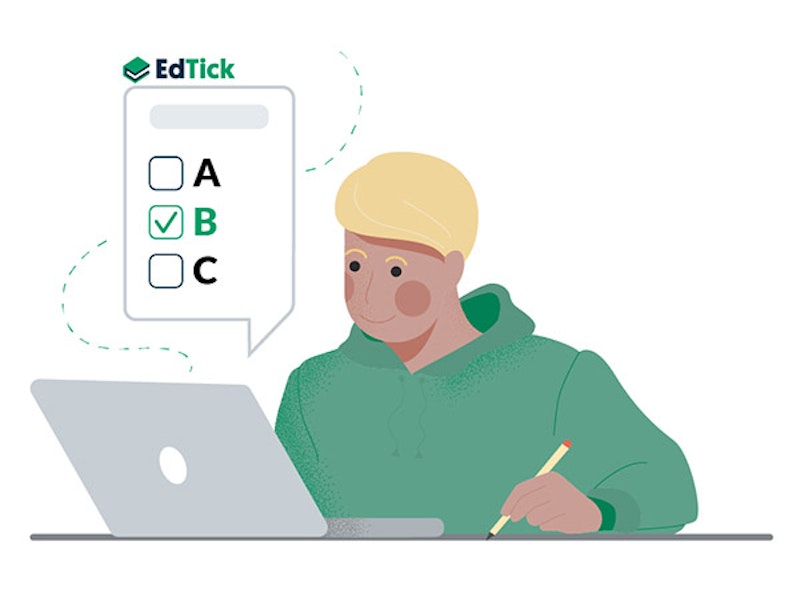Summative Assessments: 5 Tips For Approaching Them In eLearning
Due to the COVID-19 pandemic, students in nearly every country in the world have been made to switch from face-to-face classes to online courses. Educational establishments have turned to online teaching methods, and this has increased the use of summative assessments, which are a great way to evaluate students' online learning process.*
At EdTick, we want to help you improve and adapt your assessments to the virtual learning environment. In this article, we will lay out 5 steps for designing and administering excellent and useful summative assessments for online learning.
1. Acknowledge That Not Everything Has To Be Assessed
Teachers and admin staff must make strategic decisions when designing assessments, determining what students need to know and what counts as bonus knowledge. Only the essential knowledge should be evaluated in both in-person and remote learning.
However, online education is usually slower paced, and demands more time from students to master the content. Therefore, the amount of material examined in an assessment for a virtual course should generally be less than the amount for a physical class...
In order to know what is considered as essential knowledge, EdTick suggests educators follow Larry Ainsworth’s R.E.A.L. criteria. This stands for Readiness, Endurance, Assessed, and Leverage.
- Readiness: The assessment should evaluate if students have acquired the necessary competencies for this stage of the course. Use the exam as a milestone, measuring the knowledge students have gained up to this point and determining if they are ready to move on to new information.
- Endurance: The assessment should have students demonstrate knowledge that will be retained beyond the exam itself. The aim of learning is to gain skills which can be applied later in life, and the assessment should be designed according to that principle.
- Assessed: Be aware of the standards for learning set by your state or school district. The exam should ensure that the knowledge the authorities expect your students to gain is being tested.
- Leverage: The knowledge tested by the exam should be applicable to multiple disciplines. This will lead to a more robust and complete understanding for your students.

2. Presenting Performance Tasks And Performance Items
When learning online, it is crucial to consistently test students’ knowledge and adapt to the results. Performance tasks are a great way for students to demonstrate their level of understanding of a subject quickly without needing to take a full exam. These are some of the characteristics of a performance task:
They are usually open-ended questions which don’t have a single correct answer.
As students are asked to perform their knowledge, it is a great way for them to show off their proficiency.
Real-life situations are used for performance tasks; often by applying the Case Method teaching approach. This way, students can see the relevancy of what they’ve been taught.
Performance items are very similar to performance tasks, but their scope is more limited as they focus on one skill.
Both approaches are useful for testing student knowledge without needing to prepare a full assessment.

3. Divide The Work Into Manageable Portions
The pandemic has thrown everyone into uncertain and precarious times, and as a result, students may feel overwhelmed. It is important that teachers consider their student’s lives outside of school.
In order to make learning more manageable for students, we recommended that instructors divide tasks into smaller parts. This way, students can tackle them with a more relaxed path rather than cramming in one sitting. This will make it easier for students to balance work time and free time, and be more prepared for the pressure of an assessment.
4. Conversations And Verbal Communication
When teachers want to check if students have understood and internalized information, simply having a conversation may be the most effective approach. Therefore, students should be prepared to explain their way of thinking to their teacher, and the instructor should be ready to listen.
This method has two main benefits. First, it introduces a more human element to online learning, making it more like face-to-face learning, putting students more at ease. Additionally, having students explain and defend their point of view can help them build knowledge by itself.

5. Trust Your Students And Act Fairly
Cheating is certainly a possibility in online learning. However, since students online and off have access to so many resources, the likelihood of cheating in online learning is not significantly more than in person. Given the additional stress presented by online learning, it is important for teachers to trust their students. There is no need to be excessively vigilant when grading an assessment, maintain the same standards that you would for a face-to-face class.
Conclusion About Summative Assessments
In conclusion, the summative assessments are highly valuable for educational institutions and can be very useful when learning online, but only when administered properly.
At EdTick, we want to help tutors and academic staff exploring options for summative assessments used in the teaching process. To learn more about summative assessments, we encourage you to read the following article, where we explain the main differences between formative and summative assessment how summative assessments should be designed.
Undoubtedly, eAssessments and online examinations are evolving beyond traditional methods by providing much more engaging, candidate-centric, and effective assessments. If you are an educator or an administrator looking for the right online assessment software tools to improve engagement and performance, we encourage you to use EdTick’s search engine tool and read additional guidance on eAssessment and online exam implementation steps